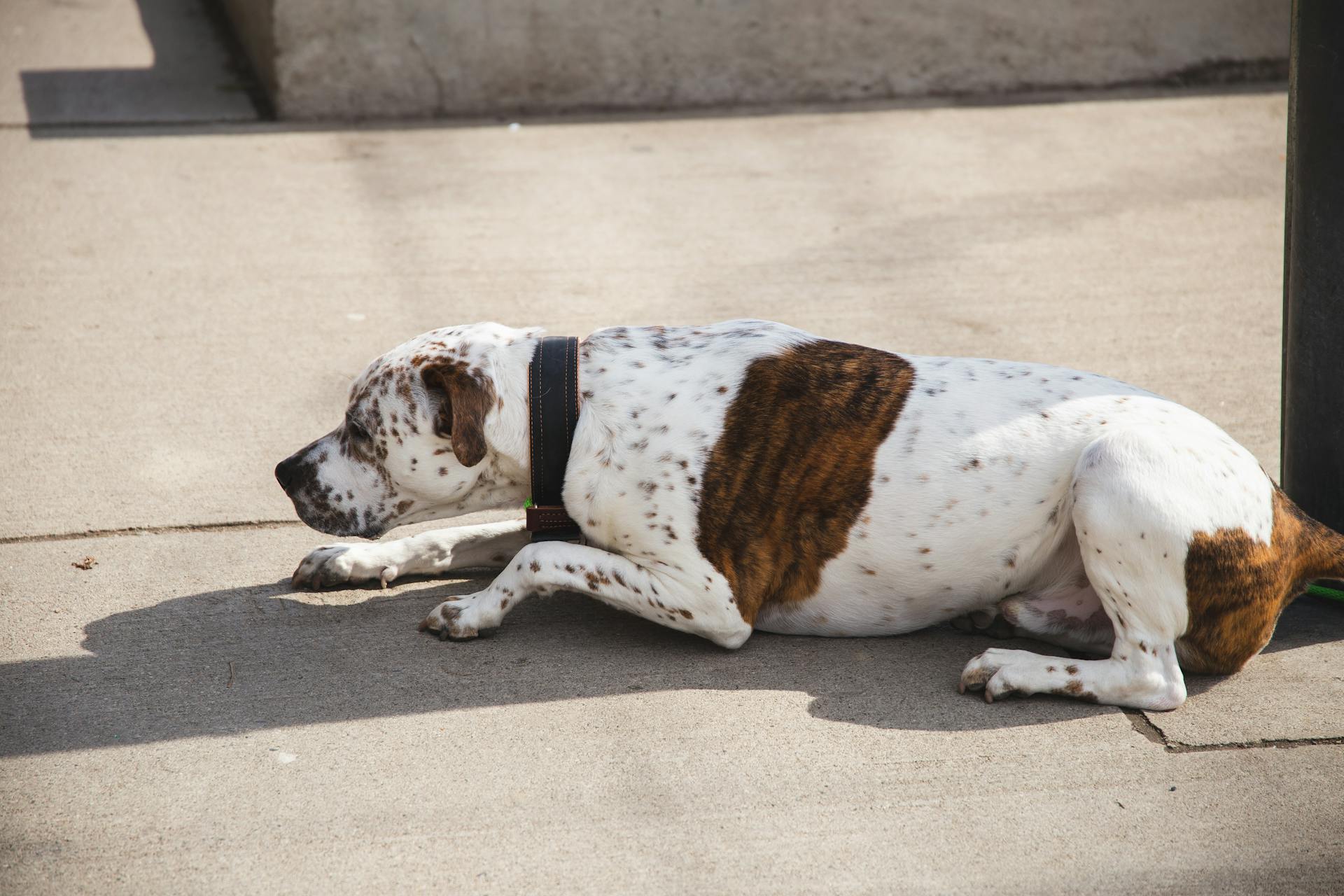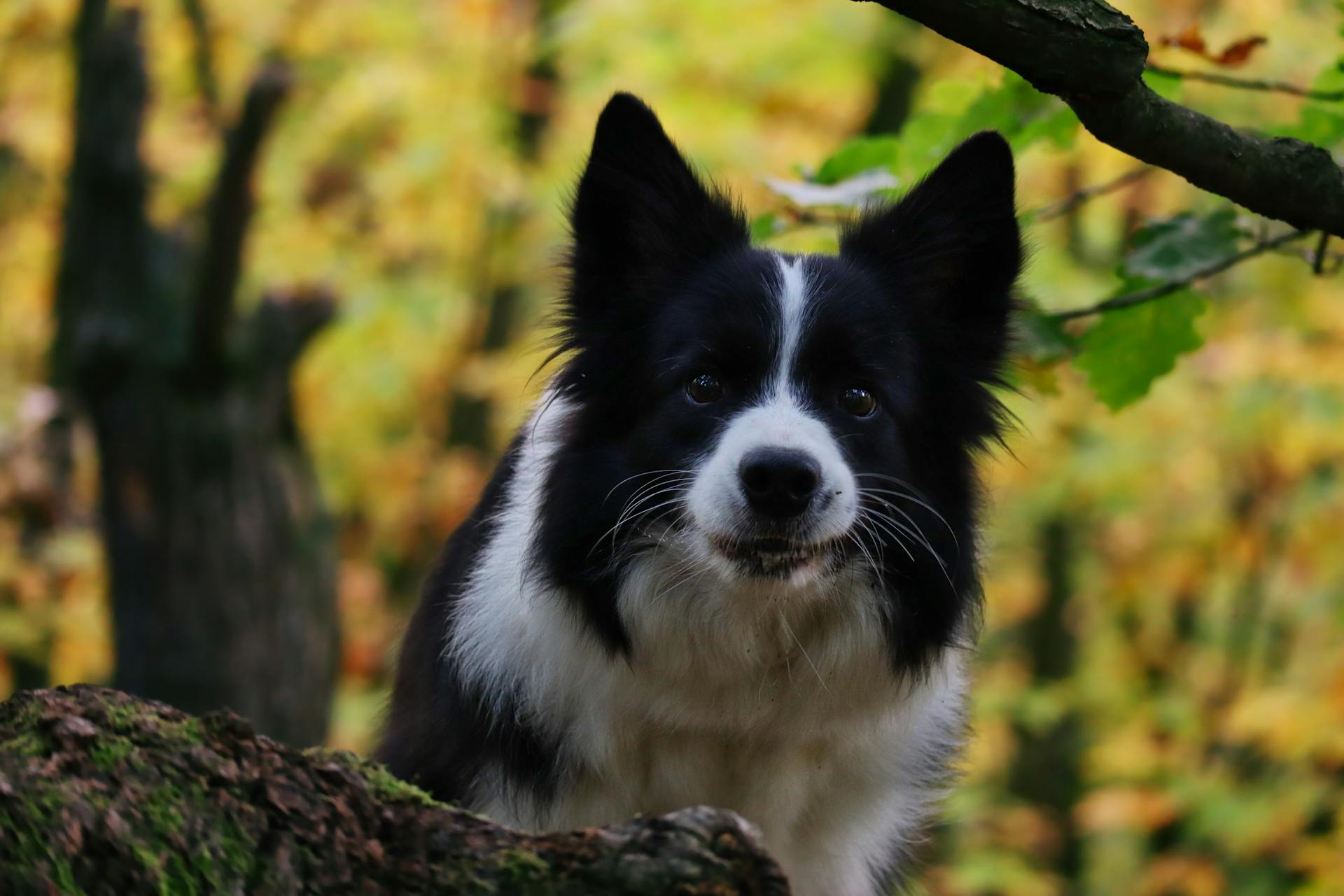
The Serbian Hound is a versatile and energetic breed that thrives on physical and mental stimulation. Originally bred for hunting small game, they have a strong instinct to chase and catch prey.
Their short, smooth coat requires minimal grooming, but they do need regular exercise to stay happy and healthy. A daily walk or run is essential, as well as playtime in a securely fenced area.
Serbian Hounds are generally good with children, but as with any breed, it's essential to socialize them properly from an early age. With proper training and care, they can make wonderful family pets.
With their high energy levels, Serbian Hounds need plenty of space to run around and play. If you're an active person or family, this breed may be a great fit for you.
Curious to learn more? Check out: How Fast Can a German Shorthaired Pointer Run
Origins and History
The Serbian Hound is an ancient breed that dates back to the 11th century. It's been used for hunting and scenting for centuries, with a rich history that spans across the Balkans.
The breed's origins are shrouded in mystery, but it's believed to have canine relatives from Asia Minor and even Egypt. Phoenician traders are thought to have brought these dogs to the Balkans around 1000 BC.
The Serbian Hound was previously known as the Balkan Hound, but its name was changed to the Serbian Hound in 1996 by the FCI. This change was made to reflect the breed's unique heritage and characteristics.
In 1924, the first breed standard was set for the Serbian Hound, and since then, the breed has remained a popular choice in Serbia, Montenegro, and other Balkan countries. Despite its popularity, the Serbian Hound is rarely seen outside of these regions, including in the UK.
The breed's hunting abilities are renowned, and they are known for being tireless and dedicated to their job. They are happy to hunt alone or in a pack, and their quarry includes deer, rabbits, foxes, and other prey.
Here are some key facts about the Serbian Hound's history:
- Believed to have originated in the 11th century
- Previous name was the Balkan Hound
- Name was changed to the Serbian Hound in 1996
- First breed standard was set in 1924
- Rarely seen outside of Serbia, Montenegro, and other Balkan countries
Characteristics and Behaviour
The Serbian Hound is a friendly dog with a relaxed and cheerful personality. They thrive on being around their family and are always eager to please.
These canines are generally easy-going and laid back, making them a great fit for families with children. They'll form a great affinity and affection with their master and any kids in the home.
The Serbian Hound is fiercely loyal and intelligent, enjoying both hunting and being a family pet. They're not too happy to be left alone for long periods of time, so a secure, fenced-in yard is a must.
A bored Serbian Hound is a destructive canine, so they need steady guidance to prevent unwanted behaviour. They're highly energetic and need lots of mental stimulation to prevent problems.
These hounds are known for their hunting skills and are tireless when tracking prey. They'll form ties with their master and adore one-on-one attention.
They're very social animals and need to be socialised from an early age to accept and greet strangers. This will ensure they're friendly towards visitors to the home.
Intriguing read: German Shorthaired Pointer Free to Good Home

The Serbian Hound is a tenacious hunter, who often prefers to go hunting alone. They usually respond well to training, especially with patient, persistent, and positive reinforcement regimes.
They're not the best choice for first-time dog owners because they need to be handled and trained by people familiar with the breed's specific needs. With the right handling, they make a wonderful companion and family pet.
They're known to be independent thinkers, which means they need to be handled with a firm yet gentle hand. They thrive on being trained to do new things and adore the one-to-one attention they receive.
Additional reading: Dog Breeds That Don't Need Grooming
Care and Maintenance
The Serbian Hound is a relatively low maintenance dog when it comes to grooming routines.
They shed hair steadily through the seasons, so be prepared for some extra sweeping or vacuuming to keep your home tidy.
Overall, their grooming needs are straightforward and easy to manage.
Grooming
Grooming is a breeze for these dogs, as they shed hair steadily through the seasons.
Their low maintenance coats require very minimal care, making them a great choice for busy owners.
They don't need frequent bathing, as their short coats dry quickly and easily.
Regular brushing can help reduce shedding, but it's not a necessity.
Shedding
The Serbian Hound is a low maintenance breed when it comes to grooming. They shed steadily throughout the year, but are considered low to moderate shedders.
You can expect to see an increase in shedding when their summer and winter coats start to grow through. This typically happens in the spring and autumn.
Their steady shedding means they require regular brushing to prevent matting and tangling.
Curious to learn more? Check out: Dogs Breeds That Start with B
Health
The Serbian Hound is generally a robust and healthy breed, with an average life expectancy of 11 to 13 years. They have a strong work ethic and can thrive in warmer climates.
Their robustness is also reflected in their ability to hunt in difficult terrains and cooler weather conditions. However, like many working dogs, they can gain weight if they cease work or are neutered or spayed.
The Serbian Hound is prone to ear infections, especially if their ears are not properly cared for. This is due to their large, floppy ears.
Consider reading: Serbian Tricolour Hound
Some potential health issues to look out for in the Serbian Hound include bloat, obesity, and joint dysplasia. These are common problems in larger breeds.
A balanced diet and regular exercise can help prevent these issues. With proper care, your Serbian Hound can live a long and healthy life, up to 12 to 14 years.
Here are some potential health issues to be aware of:
- Bloat
- Obesity
- Joint dysplasia
- Hip dysplasia
- Ear infections
Breed Information
The Serbian Hound is a scent hound that thrives in packs, making them perfect for families with kids. They're highly intelligent and love to problem-solve, often creating their own puzzle games when playing with other dogs.
Serbian Hounds are excellent companions for active families, requiring daily exercise and mental stimulation to prevent boredom. A large yard is a must, as they love to run wild in the woods.
Their independence can sometimes make them stubborn, but with experienced owners, they're relatively easy to train. However, they may be difficult for first-time dog owners to manage.
Readers also liked: Are Portuguese Water Dogs Good for First Time Owners
Serbian Hounds are great with other dogs, but may chase smaller pets if not socialized properly. They have a high prey drive, so it's essential to introduce them to small, furry animals early on.
Here are some key characteristics to keep in mind when considering a Serbian Hound:
- Loves kids
- Prefers packs
- Highly intelligent
- Great with other dogs
- Excellent hunting dog
- Very few health concerns
- Great for agility sports
- Great for people with active lifestyles
- Easy to train for experienced hunting dog owners
However, they may also have some challenges, including being:
- Stubborn
- Not hypoallergenic
- Not a good guard dog
- Extremely independent
- May bark a fair amount
- May be difficult to train
- May chase smaller, non-canine pets
- Requires a great amount of daily exercise
Ownership and Purchase
The initial cost to purchase a Serbian Hound puppy will be between £400 and £600. This is a significant investment, but it's worth considering the long-term commitment you're making to caring for this breed.
You'll also need to budget for ongoing expenses, including £80 to £120 per month for food, vet's bills, and pet insurance. This will help ensure your Serbian Hound stays healthy and happy.
Finding a breeder can be a challenge, as the breed is rare in the UK and often has a long waiting list. Be prepared for a potentially frustrating process, but don't give up – it'll be worth it in the end.
Consider reading: Shiba Inu Reach 1 Cent
Want a Dog?
If you're considering getting a Serbian Hound, it's essential to understand their breed characteristics and needs. They thrive in active families with children who can provide exercise and mental stimulation.
Serbian Hounds are highly social and love to be around people. They're great with kids, especially if socialized from an early age. They're also pack animals and prefer to hunt in groups without issues.
However, they can be stubborn and require experienced owners who can provide consistent training and socialization. They're not the best choice for first-time dog owners or elderly people who may not be able to keep up with their exercise needs.
If you're an active person who enjoys outdoor activities, a Serbian Hound might be a great fit. They're excellent hunting dogs and love to run wild in the woods. They need a large yard to roam around and daily exercise, including long walks and visits to the dog park.
A unique perspective: Best All around Dog Breed
Here are some key characteristics to consider when deciding if a Serbian Hound is right for you:
In summary, Serbian Hounds are loyal and loving companions who thrive in active families with experienced owners. If you're up for the challenge, they can make wonderful pets.
Purchase Price
The initial cost to purchase a Serbian Hound puppy will be between £400 and £600. This is a significant investment, but it's worth considering the long-term benefits of owning a dog.
You'll also need to factor in a monthly budget of £80 to £120 to cover food, vet's bills, and pet insurance.
Finding a Breeder
Finding a breeder can be a real challenge, especially if you're looking for a rare breed like the Serbian Hound. The breed is hard to come by, and it's often difficult to locate a reputable breeder.
In the UK, for example, finding a breeder can prove challenging due to the breed's rarity. The chances are you'll have to go on a very long waiting list.
The Serbian Hound is well appreciated and popular in its country of origin, but this doesn't necessarily make it easier to find a breeder elsewhere. The extremely high prices and long waiting lists can be frustrating, to say the least.
Featured Images: pexels.com


